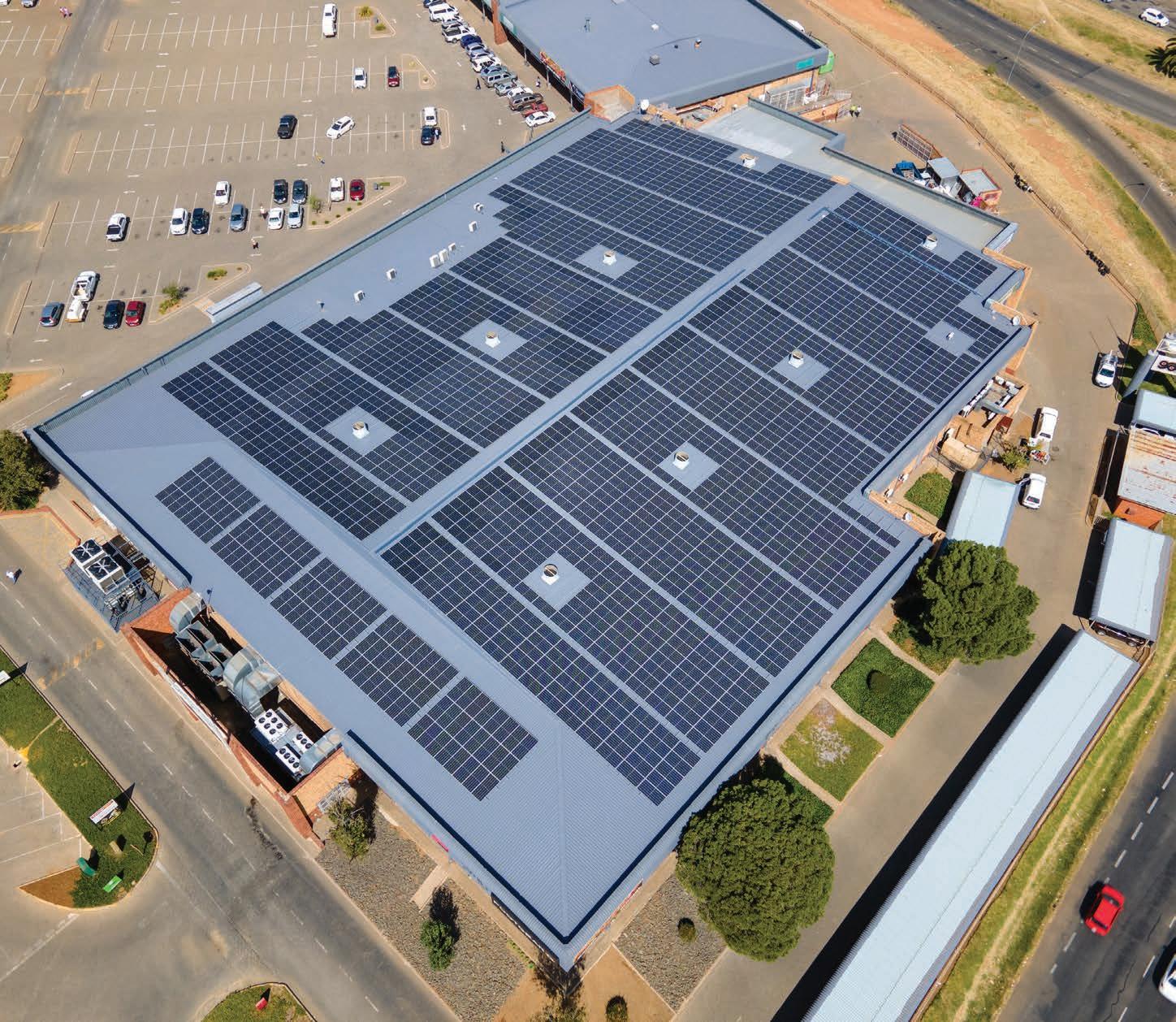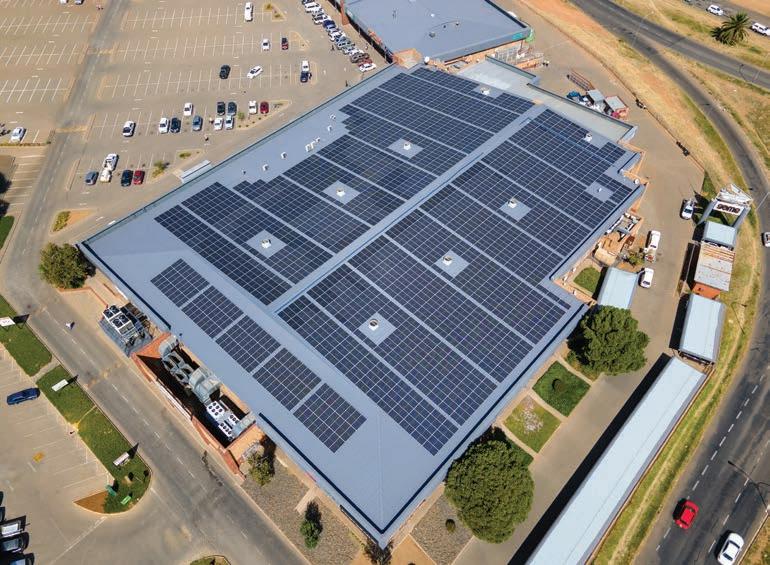INSIDE:


INSIDE:





HOW


PUBLISHED BY
Picasso Headline, A proud division of Arena Holdings (Pty) Ltd, Hill on Empire, 16 Empire Road (cnr Hillside Road), Parktown, Johannesburg, 2193 PO Box 12500, Mill Street, Cape Town, 8010 www.businessmediamags.co.za
EDITORIAL
Content Manager: Raina Julies rainaj@picasso.co.za
Contributors: Trevor Crighton, Anton Gillis, Caryn Gootkin, Jason Green, Itumeleng Mogaki, Happy Zondi
Copy Editor: Brenda Bryden
Content Co-ordinator: Natasha Maneveldt
Digital Editor: Stacey Visser vissers@businessmediamags.co.za

DESIGN
Head of Design: Jayne Macé-Ferguson
Senior Design: Mfundo Archie Ndzo
Advert Designer: Bulelwa Sotashe
Cover Image: Supplied
SALES
Project Manager: Merryl Klein merrylk@picasso.co.za | +27 21 469 2446
PRODUCTION
Production Editor: Shamiela Brenner
Advertising Co-ordinator: Fatima Dramat
Subscriptions and Distribution: Fatima Dramat fatimad@picasso.co.za
Printer: CTP Printers, Cape Town
MANAGEMENT
Management Accountant: Deidre Musha
Business Manager: Lodewyk van der Walt
General Manager, Magazines: Jocelyne Bayer
COPYRIGHT:
Financing commercial developments; and tips on maximising your property portfolio.

6
Three disruptive proptech trends in the commercial development sector; and AI and automation: the rise of smart rooms in the hospitality sector.


8
Commercial property projects are challenging, regardless of their scale, and come with interesting geographical nuances. Mauritius experienced something of a commercial property boom before COVID-19 and while recovery has been slow, it’s happening. So what does large-scale commercial property success in the island nation look like?
As the global logistics industry attempts to operate more sustainably, warehousing is coming under the spotlight since some studies estimate that as much as a quarter of the industry’s CO2 emissions come from warehouse buildings.


12
The convenience of online has disrupted conventional and traditional ways of shopping, creating a snowball effect on physical (bricks and mortar) retail structures experiencing empty spaces. What trends are being implemented to fill up empty shop spaces?


1. Optimise the gearing of your portfolio to ensure sustainability
It is critical to manage the debt applied to a portfolio of investment properties for two main reasons. One is to drive the return on equity invested in the assets by efficiently leveraging external debt. The other is to balance this desire for return against the ability to service the debt and maintain a sustainable level of liquidity and reserves to deal with any shocks.
2. Future-proof your assets
The value of an off-grid or supplementary energy solution, such as solar, cannot be overlooked. This applies to water backup too.
Existing and prospective tenants will recognise the value of energy and water security, and your asset will stand out in the market. The yield on your asset may also improve due to reduced operating costs – solar solutions, for example, can result in a lower cost/kWh than the municipality may be charging.
3. Get the right operators involved
Property management can be time intensive and requires skilled hands to manage daily operations, including rental collection and maintenance. Getting this right will ensure your assets and their occupants are well looked after while maximising returns.
The commercial property market appears to be in a difficult environment, making it much tougher for new commercial developments given the current macroeconomic dynamics, says Khumbelo Nevhorwa, senior equity analyst at Melville Douglas.

“The biggest negative drag is the current interest rate. The SA Reserve Bank has increased interest rates by 4.25 per cent over the past 12 months.
“A further hike will increase the cost of funding for new development and decrease profitability. Inflation is impacting building costs as the majority of the imports are expensive, given the rand’s depreciation. Essentially, the cost of funding has escalated and building cost per square metre has risen,” says Nevhorwa.
He adds: “We see a much slower economic outlook and a higher correlation in gross domestic product (GDP) relative to property demand. Slower GDP growth
will limit the appetite for expansion in office occupation as the employment rate will not improve. The vacancy rate in South Africa will remain stubbornly high. To develop in the office sector, pre-lease agreements, most likely at a lower rental than in the past, are needed as this sector is attracting negative reversions due to the oversupply of space.
“Retail properties have been more resilient in rural and township areas given the lower supply of malls and tenants being more skewed towards nondiscretionary. In the bigger metropolitans, an oversupply of malls continues to impact trading densities, and the higher correlation to GDP growth does not make the situation better. The positive is the reopening we saw after the pandemic. The demand for super-regional malls is now in line with historical trends,” he says.
Nevhorwa adds that the most concerning factor in development and management
4. Don’t lose sight of the detail
While you don’t necessarily need to do the books yourself, you must understand the numbers. The detail is where investors may be able to find additional return on their investments. Consider line items that may be bloated and costs that could be optimised.

5. Keep up to date with market movements
Diversification is generally considered critical at a portfolio level. However, this may not be every investor’s approach; some avoid sectors they are less in tune with. Regardless of your strategy, it is paramount for investors to stay up to date with market trends and sector-related news to capitalise on opportunities and proactively respond to threats.
of commercial property in South Africa remains the higher inflation in municipality costs (rates and taxes) and electricity. Inflation rates on these costs remain in the low- to mid-teens, and the escalation rates landlords push to tenants are between six and seven per cent, which continues to reduce margins and net property income growth for investors.
“Investors need to be forward-looking and cognisant of these obstacles when investing,” concludes Nevhorwa.
IT IS PARAMOUNT FOR INVESTORS TO STAY UP TO DATE WITH MARKET TRENDS AND SECTOR-RELATED NEWS TO CAPITALISE ON OPPORTUNITIES AND PROACTIVELY RESPOND TO THREATS.JASON GREEN, general manager at Fedgroup Property, provides five tips for maximising a commercial property portfolio
“THE COST OF FUNDING HAS ESCALATED AND BUILDING COST PER SQUARE METRE HAS RISEN.” – KHUMBELO NEVHORWA

We round up three of the biggest disruptors for property technology this year
Technology moves fast. With the accelerated developments within artificial intelligence, machine learning, virtual and augmented reality, 5G, and the internet of things, PropTech trends are set to make managing your commercial property portfolio easier and more profitable.
Here are three trends to keep your eye on.
1. Cloud-based property technology
Cloud-based property management platforms allow for easy access to information about different properties and their tenants, making it easier for managers to stay on top of things. They can also be used to help managers avoid problems with leases, such as late payments or missed rent checks.

Cloud-based software can be used to manage the systems of a building, including heating, ventilation, air-conditioning, fire alarms, security systems and lighting. The software offers a range of benefits for building owners, including improved efficiency and cost savings. It also allows users to monitor the performance of their
buildings remotely without having to visit them regularly.
Source: www.planradar.com
2. The internet of things
The internet of things (IoT) is the network of physical objects or things embedded with sensors, software and other technologies that connect to the internet to send data and react to commands. IoT allows property managers and firms to track data for predictive maintenance, analyse data to identify patterns, reduce energy waste and create secure smart buildings.
Source: www.planradar.com
3. Virtual reality
Virtual reality involves the use of technology to create an interactive three-dimensional image or environment. Through virtual staging and tours, virtual reality and augmented reality are gaining popularity in the real estate sector, but are still gaining traction as effective marketing and communication tools.

Source: www.cxotoday.com
Automation is the name of the game in PropTech and will continue being deployed across more areas, says Joshua Raphael, founder and CEO of Parket. “From estate agents to brokers, and landlords to property managers, and others, the menial time-consuming tasks that used to take up inordinate amounts of time in the past will continue to be automated.
“Communication, marketing, e-contracts, even closing deals, and more, will continue to be automated as the machines take on more of the everyday tasks so that human capital can be deployed to spend valuable time and creativity on building compelling business differentiators.
“Previously (and still in most parkades today), a driver would show up at a parkade, press a button and receive a little white ticket. This driver would then drive around the parkade looking for an open bay. Some parkades have made use of little red and green light indicators for whether the parking is open or taken.
“The person would park their car and go conduct their business. When it came time to leave, the person would find a machine and insert the ticket. If it didn’t work, or there was a problem of some kind, they would need to press a button and wait to speak to an operator to resolve the problem.
“Then they would pay, either by cash or card, and have a window period to walk to their car and make their way to the parkade exit. They would insert the ticket into a machine at the exit and the boom would raise, allowing them to drive away. In other parkades, a person sat at the exit and took payment and raised the boom.”
Parket has changed this process. “The car drives up, cameras recognise the number plate and the boom opens. The driver knows there’s open parking because they have the app, which works in real-time. They park, go about their business and leave, the boom opening as they exit, while their bank card will be charged for the time they used. Not only does this vastly improve customer experience, but it also allows landlords to generate income on open parkings while drastically reducing the time and resource management required to run a parkade effectively.”
Source: https://techeconomy.ng/
CLOUD-BASED SOFTWARE CAN BE USED TO MANAGE THE SYSTEMS OF A BUILDING, INCLUDING HEATING, VENTILATION, AIR-CONDITIONING, FIRE ALARMS, SECURITY SYSTEMS AND LIGHTING.
From artificial intelligence and automation to virtual travel and the rise of smart rooms, here are the top tech trends that ANTON GILLIS, Kruger Gate Hotel CEO, believes will dominate the hospitality industry

Technology has been rapidly transforming industries, and the hospitality industry is no exception. The convergence of tech and hospitality is on the rise and changing the way we travel, stay and experience hotels. This technological revolution has brought about numerous benefits for hotels and guests alike.
As a business solution, artificial intelligence (AI) continues to advance, becoming more reliable and appealing. Those operating in the travel industry rely heavily on providing exceptional customer service to establish their reputation, and AI technology is a powerful tool for achieving this. In the hotel industry specifically, one of the most promising applications of AI is providing online assistance to customers through chatbots and instant messaging apps. Chatbots can answer common guest questions, provide information about local
attractions, and even book reservations for restaurants or activities.
Additionally, AI and machine learning technologies that analyse guest data, including their preferences, booking history and feedback, can be used to tailor recommendations, provide customised offers and deliver personalised services that meet guests’ individual needs. For instance, if a guest typically books rooms with a king-size bed, the hotel could automatically offer a king-size room when the guest books their next stay.
The rise of smart features in hotel rooms has been a significant game-changer in the hospitality industry. With the advent of mobile apps and keyless entry systems, guests can now access their rooms without needing traditional room keys. Smart thermostats, lighting and entertainment systems allow guests personalised control over their room’s ambience, allowing them to customise their

stay to their preferences. Furthermore, in-room voice assistants can assist guests with ordering room service, making reservations or providing local recommendations. When incorporating smart features in guest rooms, robust cybersecurity measures must be put in place to protect guest data from cyber threats.
In this technological age, hotels must adapt to meet guest expectations. Failing to embrace technological advancements means a hotel risks losing market share to its competitors. Hotels must do more than keep up with the latest technological trends, they must proactively seek innovative solutions to improve their guest experience and stay ahead of the curve.
ONE OF THE MOST PROMISING APPLICATIONS OF AI IS PROVIDING ONLINE ASSISTANCE TO CUSTOMERS THROUGH CHATBOTS AND INSTANT MESSAGING APPS.
Commercial property projects are challenging, regardless of their scale, and come with interesting geographical nuances.
Mauritius experienced something of a commercial property boom before COVID-19, and the market is recovering, albeit slowly. So what does large-scale commercial property success in the island nation look like?
“While it is true that the scope of projects in Mauritius and South Africa may not differ greatly in design and implementation, there are certain challenges unique to each country,” says Daryl Jorgensen, managing director: Eris Properties Mauritius. “Mauritius, being an island, can face logistical challenges and elevated costs for certain projects. On the other hand, as a prominent developer in South Africa, we face challenges such as electricity supply, security and crime issues, which must be considered throughout the lifecycle of any development.” He says that elements such as “construction mafia” risk and local community liaison requirements must all be taken into account when structuring the time and cost of projects in South Africa, whereas they may not be as prevalent in Mauritius.
“In terms of property-related services within Mauritius, Eris has successfully developed the
first phase of an office complex adjacent to the airport. This phase comprises 4 870m2 of the 13 000m2 office complex, with a total value of US$27-million. The value of the completed works to date (Phase 1) is US$11.4-million,” explains Jorgensen. To give an idea of scale, he says that a “large” development in the Mauritian context is one to the order of MUR1-billion (+/-US$22-million), yielding anything between 10 000 and 15 000m2 of usable space.
Jorgensen says that comparing Mauritius’s position as a well-established business hub with a stable political and economic environment conducive to foreign investment with the significant current and future challenges in South Africa means it may be worthwhile considering a Mauritian property investment. “The oversupply of commercial property in Mauritius can be seen as an advantage for potential tenants because it creates a competitive market, which can lead to lower rental rates and more favourable lease terms,” he explains. “The availability of property can make it easier for businesses to find suitable premises that meet their specific needs. Operators with the ability to operate on a speculative basis can potentially perform exceptionally well as a result of these conditions, if prudent enough.”
Commercial vacancy rates are low, and monthly prime rents stand at around US$30 per m ² (+-R557) in Mauritius. Most warehousing is owner-occupied or leased by small and medium business enterprises linked to emerging sectors such as bio-farming, organic farming, recycling and green energy technology. Monthly lease rates have remained steady at US$7 per m² (+-R127), meaning that negotiations tend to be centred around the specification of units rather than cost.

Source: Knight Frank Intelligence Guide
Shevira Bissessor, Gateway Real Estate Africa (GREA) chief operating officer, says from a market depth and scale perspective, it is difficult to compare Mauritius with South Africa, especially as real estate development opportunities in Mauritius are vastly different. “Where South Africa has a mature and saturated property market, Mauritius offers significant prospects for real estate developments with an impact that goes beyond buildings.”
GREA recently completed the first phase of The Precinct, comprising a 10 000 m2 commercial office building in Grand Baie. It is the first Mauritian development to achieve a 5-Star Green Star rating from the Green Building Council of South Africa and the highest-rated green office development in the Indian Ocean Islands region. The development’s design incorporates active and passive features that lower energy consumption and carbon footprint. The entire layout supports flexibility and connectivity, future-proofing the building and optimising connectivity and staff wellbeing, which leads to greater productivity.
Bissessor says the advent of remote working has placed significant upward pressure on demand for residential and retail space, with A-grade office space in short supply across the island.
Jorgensen says: “Although the commercial property market in Mauritius has experienced its fair share of challenges, it remains a promising investment opportunity for those willing to navigate the market and take advantage of the country’s economic potential.”
Commercial property in Mauritius is experiencing an upsurge, writes TREVOR CRIGHTON
“MAURITIUS OFFERS SIGNIFICANT PROSPECTS FOR REAL ESTATE DEVELOPMENTS WITH AN IMPACT THAT GOES BEYOND BUILDINGS.” – SHEVIRA BISSESSOR

More sustainable practices in the global warehousing space can slash the industry’s – and the planet’s – CO2 emissions, writes
As the global logistics industry attempts to operate more sustainably, warehousing is coming under the spotlight. The logistics and transport sector contributes just over a third of global carbon dioxide (CO2) emissions, making it the largest-emitting sector in numerous developed countries. And that share keeps growing. In 2021, the transport sector accounted for 7.7 gigatonnes (Gt) of CO2 –an increase of 8 per cent since the lifting of pandemic measures. Today, the world’s total annual CO2 emissions are around 35Gt.
Many operators in the sector are establishing initiatives linked to the UN Sustainable Development Goals, which aim to right many of humanity’s social and economic wrongs by 2030 to stop irreversible damage to the planet.
Danish global logistics firm DSV established its own 2030 sustainability strategy in an attempt to make all aspects of the supply chain
The World Green Building Council says that buildings and construction together account for 36 per cent of global final energy use and 39 per cent of energy-related CO2 emissions when upstream power generation is included.
When it comes to green improvements across the supply chain, 12 per cent of companies believe the biggest impact can be made in warehousing.
Source: European Logistics Supply Chain Sustainability Report
The World Green Building Council’s Advancing Net Zero 2022 report shows that energy efficiency measures could reduce global emissions by 48 per cent by 2030, with 43 per cent of those coming from buildings.
They can also support grid decarbonisation and significantly reduce costs while increasing resilience, durability, comfort and productivity.
more sustainable. It aims to reduce emissions in its truck and courier operations and its warehousing operations by 50 per cent and its scope 3 emissions – those across the supply chain that it doesn’t have complete control over – by 30 per cent. “We can manage our operations, but that third pillar relies on our partners to work more sustainably too – and that pillar is responsible for 98 per cent of emissions,” says Stanley Macmillan, director: solutions at DSV South Africa.
Macmillan’s task is to make DSV South Africa’s warehousing division more sustainable. He has to satisfy DSV global’s strict demands that warehousing capitalises on its roof space and adds solar panels to supplement and sustain operations with the ultimate aim of becoming an energy producer that can sell power back into the electricity grid long-term.
Despite plentiful sunlight that makes solar power an attractive option in South Africa, Macmillan says that the way the country produces power has put it in DSV global’s

crosshairs as a major challenge to achieving its sustainability goals. “To put it in perspective, with Eskom as a coal-burning electricity provider on which we’re forced to rely, South Africa is responsible for 25 per cent of DSV’s global CO2 output. If we can start using more sustainable power sources, we can help slash that and contribute significantly to helping DSV meet its global sustainability targets.”
DSV South Africa’s sustainability journey started with a pilot project at its Raceway facility in Germiston, aimed primarily at cost savings. “We started by converting all the lighting to LED, which is common now, but wasn’t at that stage, and immediately found cost savings of 40 per cent. We added a small solar component and saved between 10 and 20 per cent more, which is significant across a 40 000 m2 facility,” says Macmillan. “We have the added stress of beating load shedding, which is now a business imperative. We have to use as much solar PV power as we can in our facilities and use systems such as DALI dimming and energy-efficient LED bulbs to maximise efficiency.”
Macmillan says that warehousing facilities need to become self-sufficient, but at the moment, the capacity is only 30 per cent. “We’re pushing to get to 60 per cent and onwards to 100 per cent. Our business case for Raceway shows that the intervention
TREVOR CRIGHTON
“WAREHOUSING FACILITIES NEED TO BECOME SELF-SUFFICIENT, BUT AT THE MOMENT, THE CAPACITY IS ONLY 30 PER CENT.” – STANLEY MACMILLAN
there has paid off in three years, which is a convincing case for expansion and scaling at other facilities. That said, going with solar PV at that scale means a return in five to seven years, which needs some thought. We’re working with our global team to learn more and secure the vast funding needed to facilitate that.”
While retrofitting existing warehousing with greener technology has yielded positive results, DSV is also incorporating sustainable elements into the design and construction of new facilities. “When we built DSV Park Gauteng on the R21, we wanted to cover the roof in solar panels, but were limited by the government to production of 1MW. When we moved in and the cap was lifted, we added 2.3MW more and are now looking to go to 5–6 MW,” says Macmillan. “We need to look at a hybrid solution though, because solar PV alone isn’t sufficient for a facility that size.”
In Cape Town, DSV is looking at wind power, placing Aeromine units on the roof of its Plumbago facility. “The engineers tell us there isn’t enough wind to produce sufficient power at the moment, but we are conducting our own study to prove that there’s plenty,” says Macmillan.
DSV’s Plumbago facility generates 2278.09 KWp from 11 740.99m2 of solar PV, while Solar City produces 603.30 KWp from 2 863.73m2
Fortress Real Estate Investments Limited has focused on installing solar PV across its retail portfolio, where demand and potential impact were greatest. “We are wrapping up the final retail installations and, as such, we have moved on to installations across the logistics portfolio. We have started with the larger logistics parks and are currently compiling an energy plan for
the rest of the portfolio,” says PC Potgieter, sustainability manager, Fortress Real Estate Investments Limited.

Fortress commenced with solar installations in May 2023 at its flagship logistics developments, the A-Grade 500 000m2 Eastport Logistics Park on the R21, close to O R Tambo International Airport, and the 358 000m2 Clairwood Logistics Park, 11km from the Durban Container Terminal.

“In addition, we have installed solar on three buildings at Louwlardia Logistics Park: USN (2022); We Buy Cars (2017) and Vodacom (currently on-site),” says Potgieter. “The solar installation at the King Pie BMO facility in Midrand and AkzoNobel at Union Park was also completed in 2022. At the end of April 2023, we installed a battery system to provide energy security at the Fortress offices in Sandton.”
Potgieter says that it’s important to remember that, in general, logistics warehouses are large but have relatively low energy consumption, which is not the case with retail buildings, as energy density per square metre of logistics warehousing is less than retail and office. “Retail properties have refrigeration, lighting, air-conditioning and other requirements that consume a lot of electricity. Most warehouses have a relatively small office component with most of the space dedicated to dry goods coming in and out of the building unless they require refrigeration (in the case of medical or foodstuffs) or employ processes such as injection moulding, for example,” says Potgieter. He cites the example of the 35 000m2 Weskus Mall, where Fortress has installed
990kWac on the roof. “We could double that output, but there is simply not enough roof space to do this. Our 20 000m2 warehouse buildings have plenty of roof space, but only require around 100–150kWac,” he says.
Fortress designs all warehousing buildings as “solar-ready”. “We build on-spec for logistics clients, so we cannot fully assess their energy requirements until the building is complete and they are operating from the site. Once the tenant moves in, we work with them to come to an arrangement on solar,” says Potgieter.
“There is massive demand for renewable energy and battery storage from our tenants, driven primarily by their desire to play their part in mitigating greenhouse gas emissions and contribute to a more sustainable future. Clearly, in sunny South Africa, solar forms the core of this move to sustainable energy solutions, and bringing battery storage into the energy mix will extend the benefits derived from solar PV.” He says that the future energy mix for a warehouse will consist of grid power, solar PV (or other renewable sources), batteries and a generator coupled with smart meters and connectivity – a complete mini-grid solution, with the implementation of a variety of energy sources allowing for sustainable, reliable and cost-effective power.


“THERE IS MASSIVE DEMAND FOR RENEWABLE ENERGY AND BATTERY STORAGE FROM OUR TENANTS, DRIVEN PRIMARILY BY THEIR DESIRE TO PLAY THEIR PART IN MITIGATING GREENHOUSE GAS EMISSIONS.” – PC POTGIETERIEA’S REPORT ON THE TRANSPORT INDUSTRY SUPPLY CHAIN SUSTAINABILITY REPORT WORLD GREEN BUILDING COUNCIL REPORT
The convenience of online shopping has disrupted conventional and traditional ways of shopping, creating a snowball effect on physical (bricks and mortar) retail structures experiencing vacant spaces.

What are some of the new ways or trends that are or should be used to fill up empty shop spaces or, at best, how do shop owners start to reimagine the retail space?
Matthew Counsell, senior property investment broker at Broll Auctions and Sale, says in South Africa, especially within urbanised nodes and cities, the supply of retail centres has increased over recent decades. As a result, as the market matures, so does the competitive nature of the market.
The evolving wants and needs of consumers have made it a priority for property owners to be flexible and remain dynamic in their property management and leasing approaches. Doing so will ensure that occupancy levels are maintained and attractive solutions are offered to fill vacant retail spaces.
In light of this, and considering the physical attributes of a centre, one needs to ask: “When I go shopping at a particular centre, what draws me to this property instead of another one?”
When repurposing a shop’s floor space, various opportunities arise. The space within any retail centre is ultimately a canvas for a business to showcase its product or service offering. The ability to repurpose a shop’s floor space allows a retailer to be dynamic in how they present themselves to the market. And, it allows tenants to reimagine their shop space and be creative in how they
relate to their target customers, which plays a significant role in improving the customer experience.
A flexible floor plate that can be tailored to the tenants’ requirements and performance enables the property owner to offer flexible lease scenarios to tenants. For example, being able to reduce a tenant’s footprint and restructure rental terms accordingly could improve affordability from a tenant perspective and assist in improving trading densities. This, in turn, could positively impact tenant retention and reduce tenant churn. Furthermore, a change in retail floor space could allow a property owner to diversify their tenant mix by offering a wider range of smaller tenants to the market.
This also assists with diversifying the risk of nonpayment by tenants, thereby improving the sustainability of income generated by the property. An example of this could be to include a value-add tenant to a centre that traditionally focused solely on a higher living standards measure target market,” says Counsell.
“One must be mindful that the nature of the tenant and its alignment with the target market is always important to consider, especially when understanding the risk profile of the centre,” Counsell adds.
For a brand that has invested in multiple retail-focused property assets in Sandton City, Nelson Mandela Square, Eastgate Shopping Centre, and Botshabelo Mall, among others, vacant retail spots are a rarity. However, as landlords and developers, Liberty Two Degrees (L2D) does keep tabs on what is happening on retail floors and has noticed several unique trends that speak directly to reimagined retail spaces.
Jonathan Sinden, chief operating officer at Liberty Two Degrees, says: “One of the most noticeable trends is that retailers are now adopting an omnichannel approach where international and national retail brands collaborate with local designers. “A good example is a David Tlale brand collaborating with Avon to produce a collection of fashion accessories exclusive to loyal customers of both brands. In the trading retail space, that translates to an increased customer footfall and creates a unique shopper experience.”
These collaborations lead to a unique and ever-evolving retail space that will be filled with two loved brands, a benefit for retailers and designers to share rental space.
Another trend is ‘“phygital”, which is essentially the concept of merging online and physical shopping. Retailers are noticing that one cannot live without the other. This approach gives customers the option to conveniently choose how, where and when to purchase and collect goods.
From a landlord’s perspective, a reimagined retail space could mean multitenant shops in one space. A perfect example is that of EGG stores – an amalgamation of different smaller brands that can’t necessarily afford their own lease being housed and logically isolated in one single shop, but physically integrated,” says Sinden.
Delivering on a great shopper experience comes down to understanding what a retailer’s target audience wants or needs in the context of their shopping mission,” says Nicola Allen, senior retail analyst at Trade Intelligence.
For some shoppers, it’s about the premium experience – they’re impressed by bespoke shop fittings and luxury touches (what some call “shoppertainment”, think the new Checkers FreshX stores). Other more price-conscious budget shoppers want the store experience to deliver a sense that shoppers are getting their value for money. In other words, that item prices aren’t inflated by the cost of a luxury shopping experience.
Looking at the growth potential of a reimagined retail space, Allen says it’s difficult to quantify, but it is definitely worth looking into.
“The FMCG grocery market is a low-margin and highly competitive one, which is why the likes of the Shoprite Group have a strategic focus area known as ‘unlocking alternative revenue’. This includes multiple initiatives that leverage the physical store, including its Money Market,” says Allen. Sinden concludes that retail is ever-evolving. “Retailers and property owners need to be conscious about the message they’re sending to their customers. L2D has made commitments in terms of its net-zero journey, and retailers are doing the same as customers become passionate about the brands they are buying and the impact on the environment.”
“THE NATURE OF THE TENANT AND ITS ALIGNMENT with THE TARGET MARKET IS ALWAYS IMPORTANT TO CONSIDER, ESPECIALLY WHEN UNDERSTANDING THE RISK PROFILE OF THE CENTRE.” – MATTHEW COUNSELL

